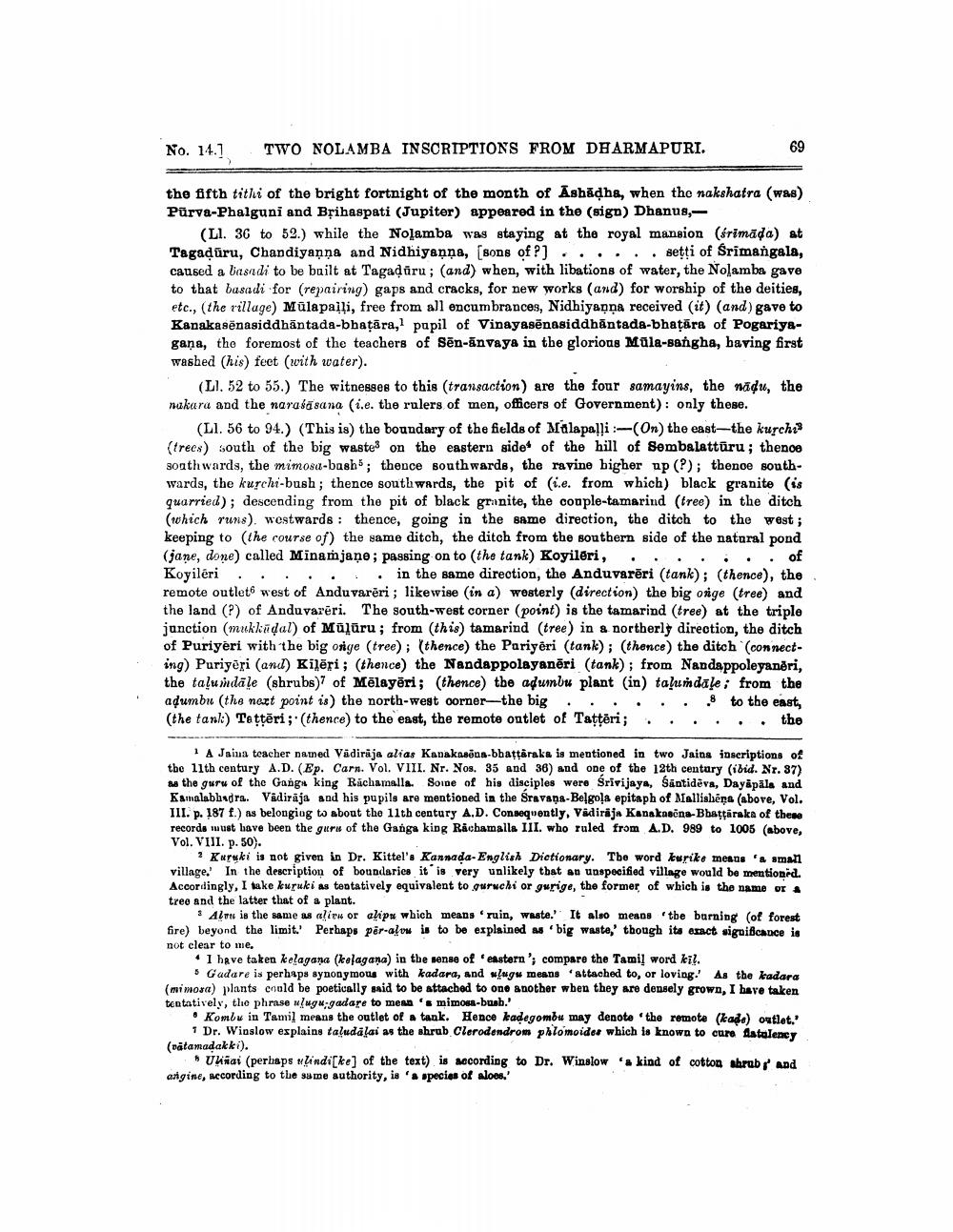________________
No. 14.1,
the fifth tithi of the bright fortnight of the month of Ashaḍhs, when the nakshatra (was) Pūrva-Phalguni and Brihaspati (Jupiter) appeared in the (sign) Dhanus,
TWO NOLAMBA INSCRIPTIONS FROM DHARMAPURI.
69
(Ll. 36 to 52.) while the Nolamba was staying at the royal mansion (śrīmāḍa) at Tagaḍuru, Chandiyanna and Nidhiyanna, [sons of ?] setti of Śrīmangala, caused a basadi to be built at Tagaḍuru; (and) when, with libations of water, the Nolamba gave to that basadi for (repairing) gaps and cracks, for new works (and) for worship of the deities, etc., (the village) Mulapalli, free from all encumbrances, Nidhiyanna received (it) (and) gave to Kanakasēnasiddhantada-bhaṭāra, pupil of Vinayasēnasiddhantada-bhațara of Pogariyagana, the foremost of the teachers of Sen-anvaya in the glorious Müla-sangha, having first washed (his) feet (with water).
(Ll. 52 to 55.) The witnesses to this (transaction) are the four samayins, the nadu, the nakara and the narasasana (i.e. the rulers of men, officers of Government): only these.
(LI. 56 to 94.) (This is) the boundary of the fields of Malapalli :-(On) the east-the kurch? (trees) south of the big wastes on the eastern side of the hill of Sembalattūru; thence southwards, the mimosa-bash5; thence southwards, the ravine higher up (?); thence southwards, the kuṛchi-bush; thence southwards, the pit of (i.e. from which) black granite (is quarried); descending from the pit of black granite, the couple-tamarind (tree) in the ditch (which runs). westwards: thence, going in the same direction, the ditch to the west; keeping to (the course of) the same ditch, the ditch from the southern side of the natural pond (jane, done) called Minamjane; passing on to (the tank) Koyileri, . of Koyileri . in the same direction, the Anduvarēri (tank); (thence), the remote outlet west of Anduvareri; likewise (in a) westerly (direction) the big onge (tree) and the land (?) of Anduvarēri. The south-west corner (point) is the tamarind (tree) at the triple junction (mukkudal) of Mülūru; from (this) tamarind (tree) in a northerly direction, the ditch of Puriyeri with the big onge (tree); (thence) the Pariyeri (tank); (thence) the ditch (connecting) Puriyeri (and) Kileri; (thence) the Nandappolayanēri (tank); from Nandappoleyanĕri, the talumdale (shrubs) of Melayĕri; (thence) the adumbu plant (in) talumdale; from the aḍumbu (the next point is) the north-west corner-the big .8 to the east, (the tank) Taṭṭeri; (thence) to the east, the remote ontlet of Taṭṭeri; the
1 A Jaina teacher named Vädiraja alias Kanakasena-bhattaraka is mentioned in two Jaina inscriptions of the 11th century A.D. (Ep. Carn. Vol. VIII. Nr. Nos. 35 and 36) and one of the 12th century (ibid. Nr. 37) as the guru of the Ganga king Rachamalla. Some of his disciples were Śrīvijaya, Santideva, Dayapala and Kamalabhadra. Vadiraja and his pupils are mentioned in the Śravana-Belgola epitaph of Mallishena (above, Vol. III. p. 187 f.) as belonging to about the 11th century A.D. Consequently, Vadiraja Kanakasena-Bhattaraka of these records must have been the guru of the Ganga king Rachamalla III. who ruled from A.D. 989 to 1005 (above, Vol. VIII. p. 50).
2 Kuraki is not given in Dr. Kittel's Kannada-English Dictionary. The word kurike means 'a small village. In the description of boundaries it is very unlikely that an unspecified village would be mentioned. Accordingly, I take kuruki as tentatively equivalent to guruchi or gurige, the former of which is the name or a tree and the latter that of a plant.
Alru is the same as alive or alipa which means ruin, waste. It also means the burning (of forest fire) beyond the limit. Perhaps per-alvu is to be explained as 'big waste,' though its exact significance is
not clear to me.
I have taken kelagana (kelagana) in the sense of eastern'; compare the Tamil word ki?.
5 Gadare is perhaps synonymous with kadara, and ulugu means attached to, or loving. As the kadara (mimosa) plants could be poetically said to be attached to one another when they are densely grown, I have taken tentatively, the phrase ulugu-gadare to mean 's mimosa-bush.'
Kombu in Tamil means the outlet of a tank. Hence kadegombu may denote the remote (kade) outlet,' 1 Dr. Winslow explains taludalai as the shrub Clerodendrom phlomoides which is known to cure flatulency (vātamaḍakki).
Uliai (perhaps lindi[ke] of the text) is according to Dr. Winslow a kind of cotton shrubs and angine, according to the same authority, is 'a species of aloes.'




